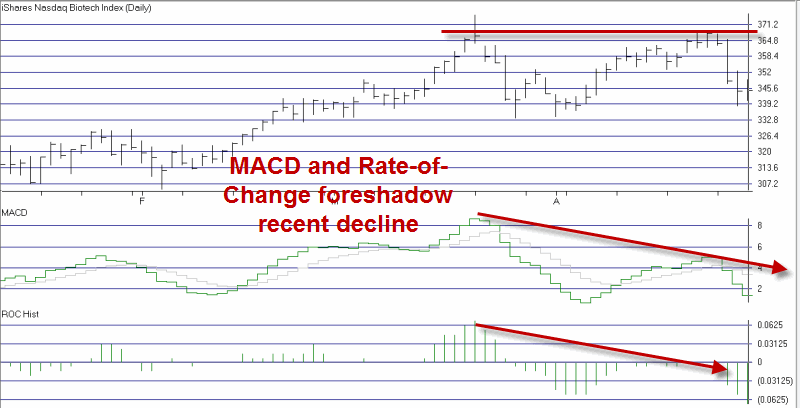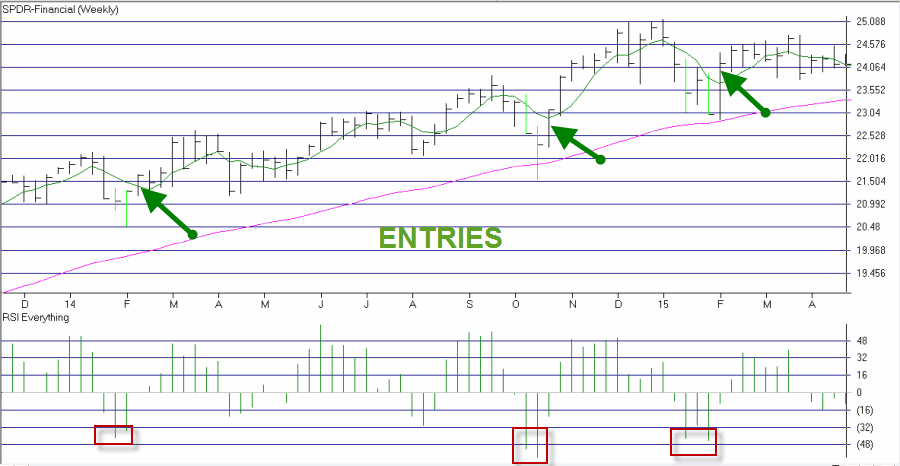If you want to talk “performance”, it’s pretty tough to beat that of biotech stocks in recent years. A quick glance at Figure 1 – a monthly bar chart for ticker IBB, the iShares biotech ETF – is sure to leave many investors shaking their heads wondering “how the heck did I not get in on that?” Figure 1 – Ticker IBB Monthly (Courtesy: AIQ TradingExpert)
Figure 1 – Ticker IBB Monthly (Courtesy: AIQ TradingExpert)
It doesn’t get much better than that.
Are the Good Times Really Over for Biotech?
Still, perspective is always in the eye of the beholder (no wait, that’s “beauty”. Well, you get the idea). A glance at Figure 2 – a daily bar chart for IBB – clearly shows a stock that has lost momentum and seemingly “run out of steam”. Figure 2 – Ticker IBB Daily with MACD and Rate-of-Change indicators (Courtesy AIQ TradingExpert)
Figure 2 – Ticker IBB Daily with MACD and Rate-of-Change indicators (Courtesy AIQ TradingExpert)
So is this finally “The Top” for biotechs? Well, it’s possible. But as a good little trend-follower, there is at least one other way to view recent biotech action.
A Buying Opportunity in Biotech?
Figure 3 displays ticker IBB along with my RSI Everything Indicator and a 200-day moving average. RSI Everything readings of -32 or less have highlighted a number of good buying opportunities in the recent past. Figure 3 – Ticker IBB with 200-day moving average and RSI Everything readings under -32 (Courtesy AIQ TradingExpert)
Figure 3 – Ticker IBB with 200-day moving average and RSI Everything readings under -32 (Courtesy AIQ TradingExpert)
Sometimes the -32 reading has been a little “early” and a further decline followed. But on many occasions the -32 reading proved to be an excellent time to buy biotech.
Factoring in Seasonalilty
Biotech stocks (with performance measured using Fidelity Select Biotech, ticker FBIOX) have showed a tendency to perform well between the end of the 5th trading day of April and the 4th trading day of June.
The growth of $1,000 invested in ticker FBIOX only during this period since 1989 appears in Figure 4. Figure 4 – Growth of $1,000 invested in ticker FBIOX from April Trading Day 5 through June Trading Day 4 (1989-present)
Figure 4 – Growth of $1,000 invested in ticker FBIOX from April Trading Day 5 through June Trading Day 4 (1989-present)
What To Do, What To Do?
The clear take away from the information shown so far is simple: there is no way to know for sure if the recent top in biotech was “the Top” or if the recent decline is a buying opportunity. But given the recent history of IBB and the slightly favorable seasonal trend, there is a way to play for a trader who at the very least feels that biotech is not about to collapse”
Figures 5 and 6 are generated from www.OptionsAnalysis.com and display a strategy known as a “bull put spread” using options on ticker IBB. Two important points should be made up front:
1. This is not a “Recommendation”. It is intended to serve only as an example of “one way to play the game.”
2. Options on ticker IBB have some seriously wide bid/ask spreads. This trade assumes that, a) a limit order was used and managed to get filled, b) at the midpoint of bid/ask spread for the two options used in the trade.
*This trade involves selling the June 315 put and buying the June 305 put.
*The profit potential for a 1-lot is $150 (or 17.65%)
*The maximum risk is $850
*As this is written ticker IBB is trading at $344.81 and the breakeven price for this position is $313.50. Figure 5 – IBB June 315-305 Bull Put Spread (Courtesy: www.OptionsAnalysis.com)
Figure 5 – IBB June 315-305 Bull Put Spread (Courtesy: www.OptionsAnalysis.com)
 Figure 6 – IBB June 315-305 Bull Put Spread (Courtesy: www.OptionsAnalysis.com)
Figure 6 – IBB June 315-305 Bull Put Spread (Courtesy: www.OptionsAnalysis.com)
While the maximum risk on this trade is $850, a close look at Figure 6 reveals that a trader could presumably cut is or her loss at a much lower amount. For example, if a trader decided to exit the position if IBB falls under say $330, the expected loss would be somewhere between $75 and $225, depending on whether the break occurs later or sooner.
A trader could also consider giving biotech a “wider berth” and hold on unless and until IBB drops below the 315 strike price. In that case the risk would be roughly $400 (Reminder for Traders: these are decisions that should be made BEFORE you enter a trade, not during the “heat of battle”).
Summary
The reason that markets “fluctuate” is because different investors and traders can view the exact same situation in different ways. As we have seen here, it is possible to make a good case that the long, large advance in biotech stocks has finally run out of steam. It is also possible to make a good case that the recent decline in biotech stocks is just another buying opportunity.
We have also seen that it can be possible – via the use of options – to make money as long as biotech stocks don’t completely come apart.
At least, that’s how I see it. How about you?
Jay Kaeppel

































